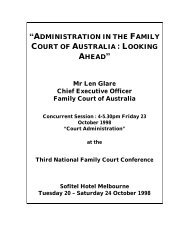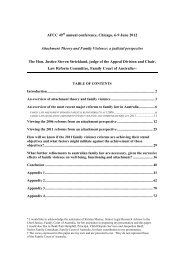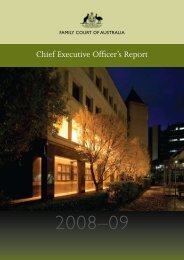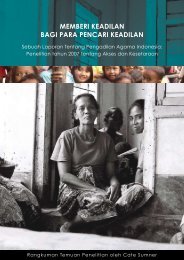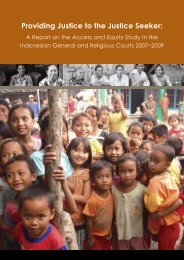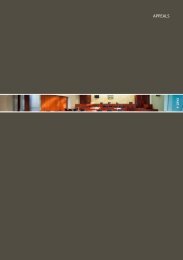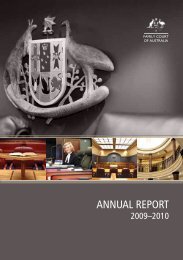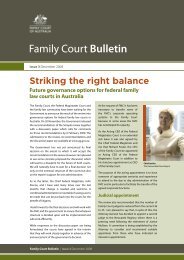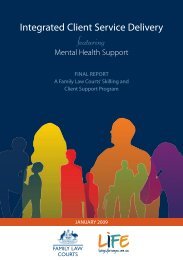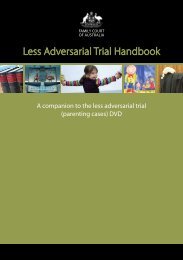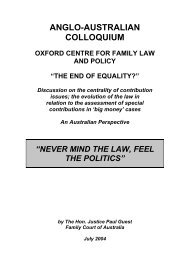Open PDF - Self represented Litigants a challenge - Size 786 KB
Open PDF - Self represented Litigants a challenge - Size 786 KB
Open PDF - Self represented Litigants a challenge - Size 786 KB
Create successful ePaper yourself
Turn your PDF publications into a flip-book with our unique Google optimized e-Paper software.
FAMILY COURT OF AUSTRALIA<br />
28 There may or may not be broader implications for the processes of the<br />
Court in matters in which both parties are <strong>represented</strong> but the primary need<br />
was seen to be adjustment to the system in circumstances where at least<br />
one party is self-<strong>represented</strong>.<br />
The Second Road – following the route of a Presumptive Path<br />
29 Somewhat to the surprise of those involved in the weekend the self<strong>represented</strong><br />
litigants were unanimously of the view that once proceedings<br />
have been commenced, the sooner a Judge became involved in the process<br />
and the sooner a judicial determination was available, the better the<br />
process would be for them. This was contrary to the expectations of most<br />
involved who had seen, in line with the practices of the Court for some<br />
time, that self-representing people would prefer the informality of<br />
alternative or primary dispute resolution processes. However, it is not clear<br />
how well informed they were with respect to the options or how much the<br />
attitude of the other party impacts on this view.<br />
30 This led to the proposal from Professor John Braithwaite that there should<br />
be a presumptive path or position which retained the objectives of<br />
procedural justice and cultural appropriateness. The first road just<br />
described might be this presumptive path. The idea of a presumptive path<br />
is simply that we presume this would be the pathway normally followed.<br />
But if there were good reasons for diverting from the presumptive path to<br />
take one of a number of alternative tracks we can do this too. This means<br />
we have a main line, a number of branchlines and a pathfinder to help<br />
litigants find the right line. This is not inconsistent with the Family Court’s<br />
existing emphasis on tailoring services to meet the needs of clients.<br />
31 The presumptive path, in general terms, would mean for most SRLs the<br />
fastest possible track between filing and judicial determination. This<br />
necessarily involves a measure of process control and also incorporates<br />
scope for opting out of that particular path and taking another, or out of the<br />
system altogether at different points depending on the individual<br />
requirements of the parties involved. There was some acceptance for an<br />
analogy of a dedicated train with a specific destination with nevertheless<br />
the possibility of stopping at different stations along the way depending<br />
upon the individual needs of the passengers. One existing example of the<br />
process of opting for an alternative pathway which incorporates a number<br />
of the features proposed by Professor Braithwaite, is the Court’s Magellan<br />
Project where the particular requirements of the parties in child abuse cases<br />
are given the advantages of additional resources, some external assistance<br />
(through the Legal Aid Offices and the Family Services Departments) and<br />
judge management towards a speedier curial disposition.<br />
62



